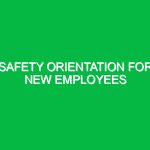In today’s fast-paced world, the importance of effective safety training techniques cannot be overstated. These techniques are vital in the Health, Safety, and Environment (HSE) domain, where they serve to protect employees, reduce workplace accidents, and ensure compliance with regulations. The right training methods not only foster a culture of safety but also empower employees with the knowledge they need to navigate potential hazards. This article delves into what effective safety training techniques entail, their relevance in HSE, associated risks, best practices, and the regulations that govern them.
Defining Effective Safety Training Techniques
Effective safety training techniques refer to a set of structured processes designed to educate employees about workplace hazards, safety protocols, and emergency procedures. These techniques aim to enhance awareness and competence, enabling workers to perform their tasks safely. Training can take many forms, including hands-on demonstrations, e-learning modules, workshops, and simulations. Each of these methods can be tailored to meet the specific needs of an organization, ensuring that the training resonates with employees and addresses the unique challenges they face.
For example, a manufacturing company might employ simulation-based training to prepare workers for potential machinery malfunctions, while an office environment might focus on ergonomic assessments and emergency evacuation procedures. The relevance of these techniques in HSE is significant; they help mitigate risks, promote safety best practices, and create a more informed workforce.
Identifying Hazards and Risks
Before implementing effective safety training techniques, it is crucial to identify potential hazards and risks within the workplace. Hazards can be broadly categorized into various types:
Physical Hazards
These include slips, trips, falls, and exposure to machinery or hazardous materials. For instance, in a construction site, workers are often at risk of falling from heights or being struck by moving objects. Understanding these risks is essential for developing specific training modules that address them.
Chemical Hazards
Employees working with chemicals face risks of exposure, spills, and reactions. Proper safety training must include information on Material Safety Data Sheets (MSDS), safe handling practices, and emergency response protocols. An example can be seen in laboratories where improper handling of chemicals can lead to serious accidents.
Biosafety Hazards
In sectors such as healthcare and pharmaceuticals, workers may encounter biological hazards, such as pathogens. Training should focus on infection control, handling of biohazardous waste, and the use of personal protective equipment (PPE).
Ergonomic Hazards
Repetitive motions, poor posture, and improper lifting techniques can lead to musculoskeletal disorders. Training programs should incorporate ergonomic assessments and safe lifting techniques to minimize these risks. For example, a company might implement training that teaches workers how to properly adjust their workstations to avoid strain.
Psychosocial Hazards
Workplace stress, harassment, and violence are significant concerns in many industries. Training should include strategies for recognizing and addressing these issues, fostering a supportive work environment.
Safety Precautions and Best Practices
After identifying potential hazards, it is essential to develop safety precautions and best practices. Here are some actionable advice and thorough explanations for effective safety training techniques:
Engagement Through Interactive Learning
Traditional lectures often fail to engage employees. Instead, interactive training techniques, such as group discussions, role-playing, and hands-on demonstrations, can enhance retention and understanding. For instance, a fire safety training session might involve a mock drill, allowing employees to practice evacuation procedures in a controlled environment.
Utilizing Technology
Incorporating technology can greatly enhance training effectiveness. Virtual reality (VR) simulations, for example, can immerse employees in realistic scenarios, helping them to respond appropriately to emergencies. A notable case is the use of VR in oil and gas training, where workers can practice emergency responses without the associated risks of real-life simulations.
Continuous Learning and Refreshers
Safety training should not be a one-time event. Regular refresher courses help to reinforce knowledge and adapt to new regulations or procedures. Implementing a schedule for ongoing training ensures that safety remains a priority. For instance, a construction firm might schedule quarterly safety refreshers, adapting content based on incident reports and new safety standards.
Personalization of Training Content
Tailoring training programs to specific job roles and industries can significantly enhance their effectiveness. Employees are more likely to engage with content that is relevant to their daily tasks. For example, a warehouse might focus its training on safe lifting techniques and the proper use of forklifts, while an office might emphasize ergonomic practices and emergency preparedness.
Feedback Mechanisms
Establishing feedback channels allows employees to voice concerns and suggestions regarding safety training. This input can help organizations refine their training programs and address any gaps. For instance, after a training session, conducting surveys can provide valuable insights into what worked well and what could be improved.
Regulations and Standards Governing Safety Training Techniques
Effective safety training is not only a best practice but also a legal requirement in many jurisdictions. Various regulations and standards guide organizations in implementing safety training:
Occupational Safety and Health Administration (OSHA)
In the United States, OSHA sets and enforces standards to ensure workplace safety. Employers are required to provide training to employees about workplace hazards and safe practices. Familiarity with OSHA standards is crucial for organizations to avoid penalties and ensure compliance.
ISO 45001
This international standard provides a framework for occupational health and safety management systems. Achieving ISO 45001 certification demonstrates a commitment to providing a safe and healthy workplace, encompassing effective safety training techniques.
National Fire Protection Association (NFPA)
For industries where fire hazards are prevalent, NFPA standards guide fire safety training and emergency response protocols. Organizations must ensure that their training aligns with these standards to adequately prepare employees for fire-related emergencies.
Local Regulations
Beyond federal standards, local regulations may impose additional training requirements based on regional risks. Organizations should remain informed about any specific local laws that pertain to their industry and geographic area.
The Continuous Evolution of Safety Training Techniques
As industries evolve, so too must safety training techniques. The rise of remote work, advancements in technology, and shifting workplace dynamics necessitate a re-evaluation of traditional training methods. Keeping abreast of new trends and continuously updating training materials will ensure that organizations remain effective in their safety initiatives.
For example, during the COVID-19 pandemic, many companies adapted their training approaches to include health guidelines related to virus transmission, promoting hygiene practices, and social distancing. This adaptability not only ensured compliance but also demonstrated a commitment to employee well-being.
Conclusion
Effective safety training techniques are essential in creating a safe and healthy work environment. By identifying potential hazards, utilizing interactive and technology-driven training methods, and adhering to relevant regulations, organizations can significantly reduce risks associated with workplace injuries. Continuous improvement and engagement through feedback ensure that safety training evolves alongside industry needs. Ultimately, investing in comprehensive safety training not only protects employees but also enhances productivity and morale within the workplace.


